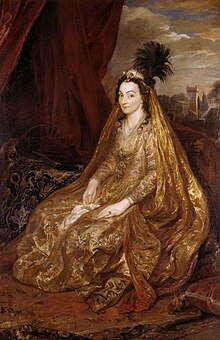Teresia Sampsonia
| Teresia Sampsonia | |
|---|---|

Lady Shirley as painted by Anthony van Dyck in Rome, 1622
|
|
| Born |
Sampsonia 1589 Safavid Empire |
| Died | 1668 (aged 79) Rome, Papal States |
| Resting place |
Santa Maria della Scala 41°53′27.81″N 12°28′3.31″E / 41.8910583°N 12.4675861°E |
| Spouse(s) | Robert Shirley |
Teresia Sampsonia (baptismal first name also written Teresa; born Sampsonia; full name after marrying Robert Shirley Lady Shirley, 1589–1668) was a Safavid noblewoman and the wife of Elizabethan English adventurer Robert Shirley, whom she accompanied on his travels and in embassies across Europe in the name of the Safavid emperor, Abbas the Great.
After the death of her husband, and due to impediments from grandees at the court and the authorities, she decided to leave Iran. She lived in a convent in Rome for the rest of her life, which she devoted to charity and religion. As a pious Christian and because of her love for her husband, she had Shirley's remains transported to Rome from Isfahan and reburied in the grave where she would also be buried.
Teresia was received by many of the royal houses of Europe, such as English crown prince Henry Frederick and Queen Anne (her child's godparents), and contemporary writers and artists such as Thomas Herbert and Anthony van Dyck. According to Herbert, Robert Shirley "was the greatest Traveller of his time"; he admired thr "undaunted Lady Teresia", whose "faith was ever Christian, her parents so noble, and her country of [ultimate] origin Circassia".
Teresia was born in 1589 into a noble Orthodox Christian (Greek or Georgian Orthodoxy) Circassian family in the Safavid Empire, ruled at the time by king (Shah) Abbas the Great. She was named Sampsonia by birth. The daughter of Ismail Khan, a brother-in-law of the Shah, she grew up in Isfahan in the Iranian royal court as an accomplished horsewoman who enjoyed embroidery and painting.
...
Wikipedia
